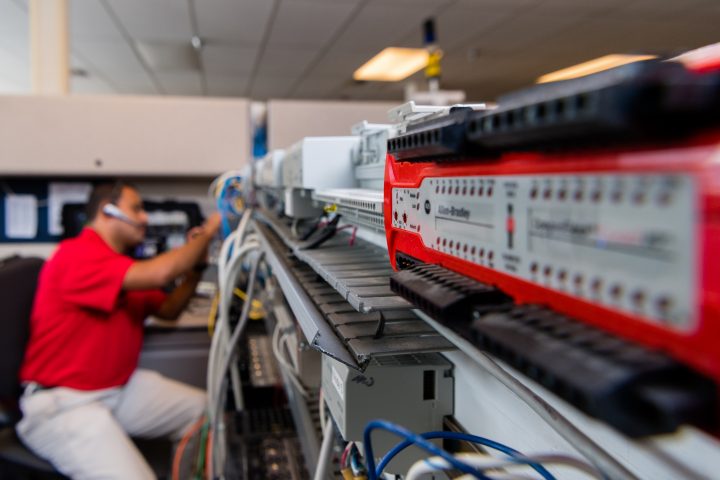
"As a company, we are trying to provide line changes with a single button. From a configuration perspective, this process should not require manual intervention," says Stephanie Wilterhalter of Rockwell Automation, explaining how digital technologies, smarter devices and systems are helping machine builders differentiate their product options.
There are a variety of digital tools to improve the hardware in production facilities and the design and operations in machine lines. These technologies enable OEMs and end users to rapidly ramp up production, minimizing downtime and preventing unexpected downtime.
With so many options, the only problem is combining all these tools to create a single solution that will fully meet the needs of OEMs and their customers. But at the Automation Fair 2019 event in Chicago, a piece of equipment from Trinks, a Wisconsin-based OEM that has operated for 100 years, on display at Rockwell Automation's Integrated Architecture booth, provided an example of how technologies work together to create a solution that can be used in the real world.
Stephanie Winterhalter, Global Portfolio Marketing Manager at Rockwell Automation, explains, "We wanted to demonstrate our end-to-end solutions of simulation, separation, design and configuration, and how our customers can accelerate production by embedding these technologies into their portfolios, providing access to actionable information for faster decisions, and how they can use these capabilities through intelligent machines."
Winterhalter continued: "Our OEMs are trying to understand how they can help their customers. We start digital software with our twin software, Emulate3D. You can try your machine without building it and you can also test your control systems".
The Application Code Manager and Machine Builder libraries give OEMs reusable code so they don't start from scratch in the process of designing machines.
William Martin, Program Manager, Network Components Program Manager at Rockwell Automation, explains, "OEMs often build and configure 80 percent of the rig and complete the remaining 20 percent in the final phase. Even if the graphics of our user interfaces (HMI) consist of copy-paste frontends. This plug-and-play technology starts with design and construction, but also brings with it the process of modification and transition between applications."
"With the automated vehicle configuration, if something fails, the maintenance team can change it in six minutes or less. Data transfer takes place automatically. As a company, we are trying to carry out line changes with a single button. "From a configuration perspective, this process should no longer require manual intervention."
Machine art
The migration of the baby boomer generation and their growing lack of competence are creating difficulties for manufacturers to monitor equipment and solve problems. "End users of the machines are losing tribal knowledge, not as knowledgeable as former employees," Martin said. They need to bring in a smarter machine. Preferably, they want to automatically identify the vehicles that are causing problems and replace them quickly."
Motor control, detection and safety are the most important features provided by the Rockwell Automation Integrated Architecture Solution, and the company is making it all smarter.
As an example, thanks to the measurability of the pressure on the pump, it is possible to measure what level of occupancy it is closed, Martin explains, "Instead of giving the on/off command for intelligent engine control, we can access more information about the engine."
Martin explains; "We can also do proactive diagnostics. For example, you can reach a limit of 950 thousand operations. They did not count operations in the past; "With smart technology, users can now measure how much uptime a device has left."

In parallel with intelligent engine controls, intelligent sensing can also rule out various manual improvements. "Our smart sensors are deployed on IO-Link. We can do the diagnosis, and the PLC can host the configuration data. You can replace a faulty sensor during operation, and the PLC can automatically detect and configure the new sensor."
Finally, intelligent security paves the way for the expected functional safety, but the security-based communication protocol GuardLink technology can combine it all. GuardLink provides enhanced functionality and flexibility with device information and diagnostics.
Intelligent operations
The Trinks machines on the Integrated Architecture stand offer an insight into the applications of vehicles, capacities and technologies.
Companies billions of dollars in size can implement this automation and standardize it to turn it into earnings in global operations, while smaller OEMs and end users can also realize benefits and value.
Winterhalter explains; "This shows scalability. We are collaborating with other digital companies and technologies and giving OEMs more options. Thus, users can create more value for themselves. Trinks realized he needed to do something more effective. Trinks' industry is more mature, and new technologies give them a more competitive advantage."
Finally, operations also require maintenance and repair after a while. "You get notifications, and using tools like augmented reality (AR), you can examine the device and figure out what the problem is," Winterhalter says.
Martin adds; "Tablets or HoloLenses can be used for augmented reality. The information immediately appears on the screen. For example, if you see that there is an overload but don't know where it is, AR helps you here too."